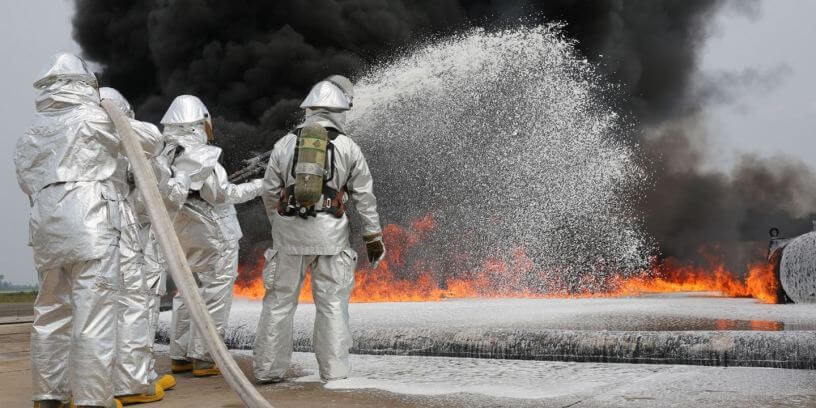Marinette PFAS Cleanup Could Begin This Summer
PFAS polluters Johnson Controls and Tyco building system to clean up forever chemicals.

Marines fighting fires with foam, a product that uses PFAS . Photo by Lance Cpl. Shawn Valosin/U.S. Marine Corps.
A system aimed at cleaning so-called “forever chemicals” from groundwater polluted in the state’s largest known PFAS contamination case is expected to be ready to operate sometime this summer.
Tyco Fire Products and Johnson Controls Inc. are building the system as part of their response to the contamination from firefighting foam developed, tested and discharged at the Tyco fire technology center near Marinette.
At a listening session conducted online Wednesday, officials from the Wisconsin Department of Natural Resources (DNR) gave residents and officials from Marinette and the Town of Peshtigo an update on the department’s continuing investigation of the PFAS contamination from the Tyco site. The contamination is the largest in the state that the DNR has identified, covering 17 square miles.
In March the state Department of Justice filed a lawsuit against Tyco and Johnson Controls in connection with the Marinette and Peshtigo contamination.
There are not yet federal or state standards for PFAS chemical contamination, although the federal Environmental Protection Agency has established a drinking water health advisory for two groups of PFAS chemicals, called PFOA and PFOS. Earlier this month, a Waukesha circuit judge ordered the DNR to stop using the Wisconsin Spills Law to require the clean-up of PFAS-related contamination.
DNR officials said they could not discuss either the DOJ lawsuit or the Waukesha County case Wednesday.
Christine Haag, director of the DNR’s remediation and redevelopment program, said the EPA is reported to be preparing to introduce its first rule this year, with final approval possible in 2023.
Those rules are now subject to review by the Wisconsin Legislature.
The fire center is located in the Town of Peshtigo, and PFAS contamination has affected residents of the town as well as Marinette, which is immediately adjacent. The Groundwater Extraction and Treatment System — GETS for short — is just one of several projects to address the contamination near the fire center.
Alyssa Sellwood, DNR remediation and redevelopment program project manager, said that the system is being built to capture and treat groundwater with the highest concentration of PFAS chemicals from the contamination — as much as 10,000 PPT to 100,000 PPT.
When the system is operating, nine wells will pull contaminated water from the ground. The water will be pumped to a treatment facility on the Tyco fire center grounds, treated to remove the PFAS contamination, and discharged into a nearby ditch to flow into the local watershed.
“The expectation is that that will improve the conditions in the groundwater, and that less PFAS will be flowing” into the ditch, Sellwood said, “And then, ultimately, less PFAS flowing into the bay of Green Bay.” Those outcomes could take decades, she said.
“But when we think about environmental cleanup, it’s really essential that we start at the source,” she said. “So we need to really clean up and start removing … that most highly contaminated material. This is really essential.”
PFAS contamination has also been found in wells near fields that have been spread with treated wastewater solids from the Marinette wastewater treatment plant.
In an area within 1,200 feet of those fields, Tyco and Johnson Controls paid for testing 191 private wells. Of those, 30 were found to have PFAS concentrations that exceeded recommendations from the Wisconsin Department of Health Services (DHS), and the companies have provided bottled water to the owners of those wells.
Sellwood said that the DNR has asked Tyco and Johnson Controls to test more wells. So far the companies have declined, but offered bottled water to the owners of 196 additional properties, she said.
The companies plan soil and groundwater tests of five fields that have used the wastewater solids. Sellwood said those test results are expected by the end of 2022.
The DNR asked the companies to test wells in a larger area, but Sellwood said company officials insisted that the contamination from the Tyco site couldn’t have reached those properties.
“This kind of put us in a stagnation point or a stall point in their site investigation that led to little progress in making determinations on the degree and extent of contamination,” Sellwood said. The DNR subsequently arranged tests of the larger area, and 32 wells had levels of PFAS that were greater than DHS had recommended.
By the end of 2022, a permanent network of monitoring wells — required as part of contamination investigations, Sellwood said —will be installed, making it possible to update the contamination data. That will make it possible to start tracking how PFAS has migrated in surface waters and groundwater, she said.
First step in Marinette PFAS cleanup to begin later this year was originally published by the Wisconsin Examiner.
More about the PFAS Problem
- Bipartisan Push to Tell Counties Faster When Water Tests Fail - Henry Redman - Dec 19th, 2025
- MKE County: County Seeks to Sue PFAS Producers, Oil Companies - Graham Kilmer - Dec 10th, 2025
- Wisconsin Reviewing EPA-Approved Pesticides For PFAS - Danielle Kaeding - Dec 9th, 2025
- State Nears Settlement with Johnson Controls/Tyco Over PFAS Spills - Danielle Kaeding - Dec 4th, 2025
- Senate Bill Promotes Soybean-Based Firefighting Foam to Replace PFAS - Danielle Kaeding - Dec 2nd, 2025
- Test Results Show High PFAS Levels in Wisconsin’s Landfill Runoff - Danielle Kaeding - Dec 2nd, 2025
- Wisconsin Communities Get $282 Million for Drinking Water Projects - Danielle Kaeding - Nov 19th, 2025
- Gov. Evers, DNR Announce $282 Million to Improve Drinking Water Quality for Wisconsinites in 74 Municipalities - Gov. Tony Evers - Nov 18th, 2025
- Cleanup of PFAS Could Cost Wisconsin Billions - Danielle Kaeding - Nov 13th, 2025
- Cleanup PFAS Without Penalizing Innocent Landowners - Wisconsin Manufacturers & Commerce - Nov 4th, 2025
Read more about PFAS Problem here




















